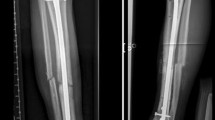Abstract
Post-traumatic large bone defects of more than 4 cm occur sometimes in open lower extremity fractures. Management of this kind trauma can be a challenge to orthopedic surgeons. We have managed this kind of bone defect by the use of free non-vascularized fibular strut bone grafts (FNVFG) harvested subperiosteally and held by screw fixation of the strut ends to the ends of the bone defect. Ten patients, eight males and two females, with a mean age of 44 years (range 26–76 years) underwent this procedure. The length of defect was 7.0 cm on average (ranging from 4 to 8 cm). Ten grafts (100 %) united at both ends within an average of 6 months (range 5–9 months). Nine patients walked independently, and one patient walked with a stick. FNVFG is a simple procedure and a reliable method to bridge huge bone loss due to open fractures of lower extremities successfully in selected cases.



Similar content being viewed by others
References
Rigal S, Merloz P, Le Nen D, Mathevon H, Masquelet AC (2012) Bone transport techniques in posttraumatic bone defects. Orthop Traumatol Surg Res 98:103–108
Masquelet AC (2003) Muscle reconstruction in reconstructive surgery: soft tissue repair and long bone reconstruction. Langenbecks Arch Surg 388:344–346
Malizos KN, Zalavras CG, Soucacos PN, Beris AE, Urbaniak JR (2004) Free vascularized fibular grafts for reconstruction of skeletal defects. J Am Acad Orthop Surg 12:360–369
George B, Abudu A, Grimer RJ, Carter SR, Tillman RM (2008) The treatment of benign lesions of the proximal femur with non-vascularised autologous fibular strut grafts. J Bone Joint Surg Br 90:648–651
Salai M, Horoszowski H, Pritsch M, Amit Y (1999) Primary reconstruction of traumatic bony defects using allografts. Arch Orthop Trauma Surg 119:435–439
Enneking WF, Eady JL, Burchardt H (1980) Autogenous cortical bone grafts in the reconstruction of segmental skeletal defects. J Bone Joint Surg Am 62:1039–1058
Mnaymneh W, Malinin TI, Makley JT, Dick HM (1985) Massive osteoarticular allografts in the reconstruction of extremities following resection of tumors not requiring chemotherapy and radiation. Clin Orthop Relat Res 197:76–87
Weiland AJ, Moore JR, Daniel RK (1983) Vascularized bone autografts. Experience with 41 cases. Clin Orthop Relat Res 174:87–95
Lee KS, Han SB, Baek JR (2004) Free vascularized osteocutaneous fibular graft to the tibia in 51 consecutive cases. J Reconstr Microsurg 20:277–284
Stevanovic M, Gutow AP, Sharpe F (1999) The management of bone defects of the forearm after trauma. Hand Clin 15:299–318
Paley D (1990) Problems, obstacles, and complications of limb lengthening by the Ilizarov technique. Clin Orthop Relat Res 250:81–104
Theis JC, Simpson H, Kenwright J (2000) Correction of complex lower limb deformities by the Ilizarov technique: an audit of complications. J Orthop Surg (Hong Kong) 8:67–71
Hertel R, Pisan M, Jakob RP (1995) Use of the ipsilateral vascularised fibula for tibial reconstruction. J Bone Joint Surg Br 77:914–919
Haw CS, O’Brien BM, Kurata T (1978) The microsurgical revascularisation of resected segments of tibia in the dog. J Bone Joint Surg Br 60-B:266–269
al-Zahrani S, Harding MG, Kremli M, Khan FA, Ikram A, Takroni T (1993) Free fibular graft still has a place in the treatment of bone defects. Injury 24:551–554
Omololu B, Ogunlade SO, Alonge TO (2002) Limb conservation using non vascularised fibular grafts. West Afr J Med 21:347–349
Morsi E (2002) Tibial reconstruction using a non-vascularised fibular transfer. Int Orthop 26:377–380
Onuba O (1988) Chronic osteomyelitis. Use of ipsilateral fibular graft for diaphyseal defects of the tibia. Trop Geogr Med 40:139–142
Steinlechner CW, Mkandawire NC (2005) Non-vascularised fibular transfer in the management of defects of long bones after sequestrectomy in children. J Bone Joint Surg Br 87:1259–1263
Falder S, Sinclair JS, Rogers CA, Townsend PL (2003) Long-term behaviour of the free vascularised fibula following reconstruction of large bony defects. Br J Plast Surg 56:571–584
Gao YS, Ai ZS, Yu XW, Sheng JG, Jin DX, Chen SB, Cheng XG, Zhang CQ (2012) Free vascularised fibular grafting combined with a locking plate for massive bone defects in the lower limbs: a retrospective analysis of fibular hypertrophy in 18 cases. Injury 43:1090–1095
Pho RW, Levack B, Satku K, Patradul A (1985) Free vascularised fibular graft in the treatment of congenital pseudarthrosis of the tibia. J Bone Joint Surg Br 67:64–70
Han CS, Wood MB, Bishop AT, Cooney WP 3rd (1992) Vascularized bone transfer. J Bone Joint Surg Am 74:1441–1449
Nather A, Goh JC, Lee JJ (1990) Biomechanical strength of non-vascularised and vascularised diaphyseal bone transplants. An experimental study. J Bone Joint Surg Br 72:1031–1035
Lin CH, Wei FC, Chen HC, Chuang DC (1999) Outcome comparison in traumatic lower-extremity reconstruction by using various composite vascularized bone transplantation. Plast Reconstr Surg 104:984–992
de Boer HH, Wood MB, Hermans J (1990) Reconstruction of large skeletal defects by vascularized fibula transfer. Factors that influenced the outcome of union in 62 cases. Int Orthop 14:121–128
Beris AE, Lykissas MG, Korompilias AV, Vekris MD, Mitsionis GI, Malizos KN, Soucacos PN (2011) Vascularized fibula transfer for lower limb reconstruction. Microsurgery 31:205–211
Vail TP, Urbaniak JR (1996) Donor-site morbidity with use of vascularized autogenous fibular grafts. J Bone Joint Surg Am 78:204–211
Pacelli LL, Gillard J, McLoughlin SW, Buehler MJ (2003) A biomechanical analysis of donor-site ankle instability following free fibular graft harvest. J Bone Joint Surg Am 85-A:597–603
Conflict of interest
None.
Author information
Authors and Affiliations
Corresponding author
Rights and permissions
About this article
Cite this article
Lin, KC., Tarng, YW., Hsu, CJ. et al. Free non-vascularized fibular strut bone graft for treatment of post-traumatic lower extremity large bone loss. Eur J Orthop Surg Traumatol 24, 599–605 (2014). https://doi.org/10.1007/s00590-013-1342-7
Received:
Accepted:
Published:
Issue Date:
DOI: https://doi.org/10.1007/s00590-013-1342-7




